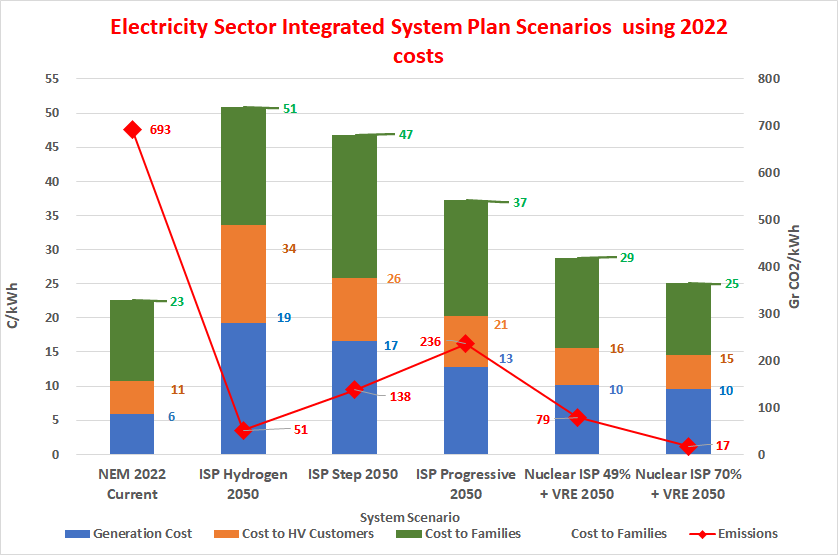
The Economics of Nuclear
The Economics of Nuclear Energy in Australia
On this previous page Our Analysis of the Grid we’ve looked at six energy scenarios and the complexities of using increasing amounts of renewables and the massive grid expansion they would require.
We’ve looked at the simplicity of a system that uses mainly nuclear energy on this page Nuclear Energy – Low Cost, Low Carbon, Reliable
In the following image we summarize the cost benefits of a system that uses nuclear energy compared to those that exclude it
IN SUMMARY< A SYSTEM THAT USES NUCLEAR ENERGY WILL COST AROUND HALF THAT OF ONE THAT EXCLUDES IT AND EMISSIONS ARE LOWER
- Vertical scale is the cost in Cents per kilowatt hour of electricity
- In blue the base generation costs of electricity which is similar to the wholesale electricity price
- In orange we have the added increment for High Voltage customers such as major industrial and transport systems
- In green we have the added cost for Low voltage users such as general commercial and domestic customers
Six schemes are shown.
SCENARIO 1 – NEM 2022 CURRENT – The first is the existing generation mix which was modeled to ensure the costs used and emissions intensities would be close to the reality of both our wholesale electricity market and the resulting emissions intensity. Cost to low voltage customers is 23 cents/kWh and emissions intensity is 693 gr CO2/kWh. Generation total is 200TWh/yr
SCENARIO 2 – ISP HYDROGEN 2050 – The second scheme is for AEMO’s proposed Hydrogen Superpower which has 100% renewable wind and solar with 770 GWh of energy storage coming from 79GW of storage capacity. AEMO have nominated 1509TWh/yr in this scenario as the demand in 2050. We found it did not meet the energy demand and had to increase the generating capacity to 1,495 GW and storage capacities to 1,669 GWh. It is a very costly concept due to low capacity factors, large amounts of spilled energy and large increases in transmission and distribution. Cost to low voltage customers is 51 cents/kWh and emissions intensity is 51 gr CO2/kWh which comes from huge amounts of embodied emissions.
SCENARIO 3 – ISP STEP CHANGE 2050 Next, we have AEMO’s step Change scenario in 2050. AEMO’s generating and storage capacities had to be increased to provide enough energy to meet demand with Generating capacity of 338 GW and storage of 1,396 GWh. AEMO have nominated 516TWh/r as the demand under this scenario in 2050. It includes 21GW of open cycle gas. Cost to Low voltage customers is 47 cents/kWh and a moderate emissions intensity of 138 gr CO2/kWh.
SCENARIO 4 – ISP PROGRESSIVE CHANGE. The fourth scenario is the less ambitious AEMO Progressive scenario in 2050. Cost to low voltage customers is 37 cents/kWh and emissions intensity of an unacceptably high 236 gr CO2/kWh. AEMO have nominated 538 TWh/r as the demand under this scenario in 2050This scenario still has 30GW of Open Cycle gas to achieve the energy demand. It has 260GW of generating capacity and 789GWh of storage
SCENARIO 5 – NUCLEAR ISP 49% + RE The fifth scenario generates 49% nuclear energy. The costs of operation the nuclear power plants is increased by having to operate with solar energy thereby reducing their capacity factors to 76.5%. This scenario has total generating capacity of 161GW and storage of 510GWh It also includes 11GW of open cycle gas plants Cost to low voltage customers is 29 cents/kWh. We have matched AEMO’s Step change demand of 516TWh/r in this scenario in 2050 The emissions intensity reflects the benefits of nuclear energy with 79 gr CO2/kWh.
SCENARIO 6 – NUCLEAR ISP 70%+RE Finally the best cost and emissions performance comes from the 70% nuclear energy scenario with a cost to low voltage customers of 25 cents/kWh and emissions intensity of 17 gr CO2/kWh. This is a fully decarbonised ultra low emissions scenario. Total generating capacity is 126 GW with 460 GWh of storage. We have matched AEMO’s Step change demand of 516TWh/r in this scenario in 2050
Scheme six will be the basis for discussion on following pages of what reactors we should build, where we should build them and how long it would take.
This table gives an overview of the generators and storage that make up the Nuclear Integrated System Plan for Scheme 6
It matches the AEMO Step Change Demand in 2050 of 516 TWh/yr
Capital costs apply for year 2022 as published in CSIRO GenCost except for nuclear where cost were derived for a variety of sources
| Generator | Type | Installed Capacity
MW |
Capacity factor
% |
% of Load Energy Supplied | Capital Cost
$/kW |
| Nuclear Power | Hybrid system of BWRX 300 Small and large GW scale Nuclear Power Plants | 50,000 | 81 | 70 | 7,402 |
| Hydro | Elevated Lake flow | 7,208 | 25 | 3.1 | NA existing |
| Solar PV | Roof Top, behind the meter | 21,478 | 14.9 | 5.4 | 1,333 |
| Solar PV | Utility Grade | 35,000 | 26.1 | 15.5 | 1,441 |
| Wind | On Shore | 11,500 | 33.5 | 6.5 | 1,960 |
| Storage | 2,516 | ||||
| Battery | 4,500 | 1.6 | 470 | ||
| Pumped Hydro | 4,000 | 20.0 | 2,706 |

